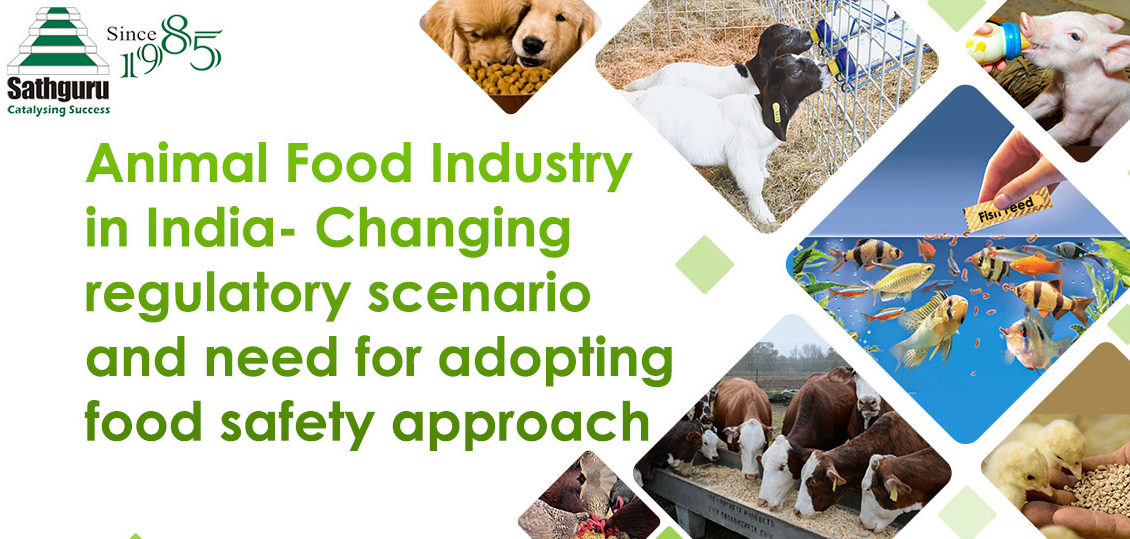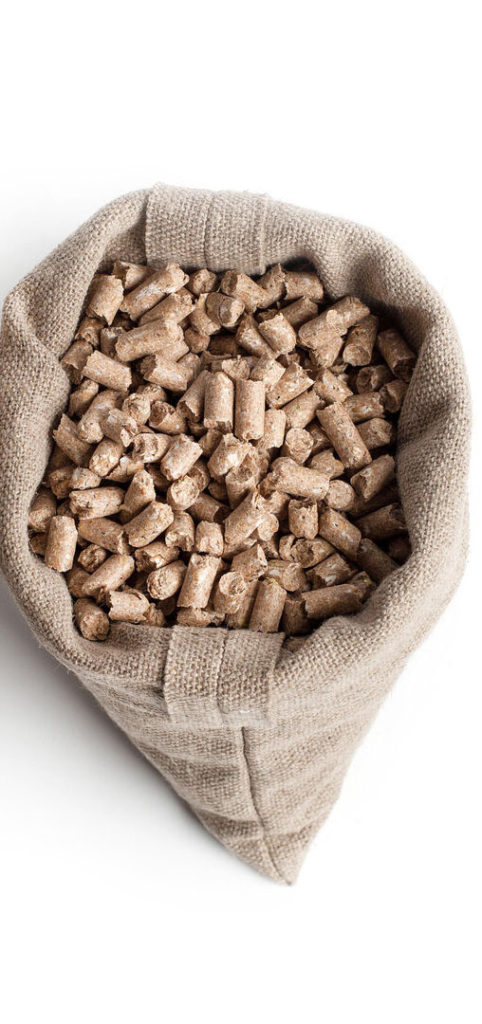
Animal Food Industry in India- Changing regulatory scenario and need for adopting food safety approach
Animal food is a collective reference to feeds for bovine (cattle), equine, caprine, swine, poultry and aquaculture species; and pet food for dogs, cats, and other pet species. Feed ingredients and supplements can also be considered as a subset of animal food. These segments of animal food are well-differentiated and regulated in developed markets like the US, Europe, and Australia. In India, unlike developed countries, dairy cattle or poultry rearing has mostly been taken up as secondary activity in addition to conventional agriculture. Cattle rearing has been carried out mostly by letting the cattle to feed on agricultural by-products or grazing in open lands and poultry rearing has been carried out as back yard poultry by utilizing the kitchen and household waste. These practices have shaped the feed consumption patterns which in turn determined how the industry is today. Aquaculture and poultry have transformed into mainstream sectors gradually over time, at least in clusters, which also led to the adoption of formulated feed in these sectors. Though dairying also evolved to a large and modernized sector, large scale organized rearing of cattle is still not prevalent, limiting the adoption of formulated cattle feed. Due to the shortage of fresh fodder, this situation is also changing in recent times, with more farmers leaning towards formulated feed. In the case of pet food, an increasing number of people owning pets and increased spending towards pet food have contributed to the growth of the pet food industry in recent times. However, when compared to countries like the US, UK and European countries the per capita spending on pet food is way less in India.

The commercial feed industry in India is estimated to be close to 28 million metric tons and caters largely to poultry feed (70-75%), aquaculture feed (10-12%), and dairy feed (10-15%). In 2019, India exported 123830 MT of various kinds of animal feed to the world, valued at 228 million USD, representing 1.5% of worlds export. Another 9200 MT of dog and cat food, valued at 37 million USD is exported to global markets in 2019. Among these two categories, around 10000 MT of animal feed (excluding cat and dog food) and 1650 MT of cat and dog food were exported to US markets in 2019. The relative ranking of India in exports for both categories is not significant. However for certain niche categories like non-GM soya and non- GM corn, India is one of the key suppliers, apart from feed supplements. The pet food market in India is estimated to be around 280 million USD in 2019.
The animal food industry in India is not stringently regulated as there are no regulatory standards available for the category to control the feed safety aspects, barring few regulations which address the issues partially. Imported pet food of animal origin is regulated through “Pet food products of animal origin (import to India) order, 2008 for controlling the entry of any zoonotic pathogens like BSE, avian influenza, etc. Although, Department of Animal Husbandry, Dairying, And Fisheries has made it mandatory to adopt BIS standards for compounded feed, these standards lack a feed safety approach. Due to increasing concerns of hazards arising from animal food to human food chain and zoonotic diseases, FSSAI has proposed to bring regulations for animal feed to control the seepage of contaminants like Heavy metals, Antibiotics, and Mycotoxins to foods of animal origin. In the National Milk and Quality Survey 2018, it was found that the levels of Aflatoxin M1 in the samples of milk irrespective of the size of dairy farmers or companies. In the interim, FSSAI made it mandatory for commercial feed companies to comply with relevant BIS standards. The companies were given six months which ends with June 2020, to comply with the interim changes. FSSAI proposed to set regulatory values or recommendations through the change of existing legislation in order to limit the exposure of animals to these chemical hazards through the feed. FSSAI plans to work together with the Ministry of Animal Husbandry, Dairying and Fisheries, and NDDB to build capacity in the animal feed sector. In the case of pet foods, the domestic sector lacks any kind of standards, leaving the companies to draw their own standards. However, lack of scientific approach in drafting such voluntary standards can have unaddressed food safety issues which may cause adverse health effects to pet animals. Also, the lack of science-based standards leave the small companies at a disadvantage compared to large companies that can spend on R&D. India possesses all the right factors like rich animal population, diverse raw material availability, increasing pet ownership, and spending on pets to develop the animal food industry. Adoption of a science-based approach in addressing the food safety issues in animal feed will lead to the overall growth of the sector as well as contributing to the welfare of animals.

As discussed above, India exports a small quantity of feed and feed ingredients to the US. Though the current volume of exports is low, the niche production factors like Organic, Non-GM grains and oil cakes, feed ingredients like nutritional supplements, pre/probiotics, enzymes, etc., will definitely help in increasing the exports, provided we adopt the necessary standards and comply with the prevailing regulations. USFDA’s new Food Safety Modernization Act has brought in sweeping changes, making the manufacturer or importer responsible for ensuring the safety of food or feed entering into the US. One of the seven rules of the FSMA –“Preventive Controls for Animal Food (PCAF)” now mandates that the animal food manufactured outside the US for US markets should meet the same standards as the animal food manufactured by the US entities. The PCAF rule has caused quite a ripple in the domestic as well as foreign feed industries’, as concepts like cGMP, Hazard Analysis, and Supply Chain Program are quite alien to the stakeholders. As the compliance dates have come into effect already, the companies are also adopting the new guidelines.
The Salient features of the Current Good Manufacturing Practice, Hazard Analysis, and Risk-based Preventive Controls for Animal Food regulation (referred to as the Preventive Controls for Animal Food regulation) are:
- Facilities that manufacture, process, pack and hold animal food for consumption in the United States must comply with the PCAF regulation. In addition, animal foods covered under specific cGMP regulations must still comply with respective regulations like Low acid canned food, Medicated feed, in addition to the general requirements of the PCAF rule.
- A “Preventive Controls Qualified Individual “is required to perform important duties like – to prepare the food safety plan, to validate preventive controls, to review records and to perform reanalysis of the food safety plan. One can become a PCQI by completing training in the development and application of risk-based preventive controls at least equivalent to that recognized under a standardized curriculum recognized as adequate by FDA, or is otherwise qualified through job experience.
- Current Good Manufacturing Practices are now to be adopted to establish a baseline standard for the production of safe animal food and the creation of a successful Food Safety Plan. Components like plant and grounds, personnel, Sanitation, etc. are covered under this part.
- A written food safety plan must be prepared by PCQI covering the below aspects.
- A hazard analysis is needed to be performed to identify any known or reasonably foreseeable physical, chemical biological hazard is linked with the animal food or facility. A preventive control need to be adopted for any such identified hazard depending on the severity and probability of the risk associated with Hazard.
- A Preventive control can be a process preventive control, sanitation control, supply chain control, or other control adopted to eliminate or reduce the hazard to safe levels.
- Supply chain program, recall plan, monitoring and implementation procedures, corrective action procedures and verification procedures as required need to be adopted.
- Records need to be maintained for hazard analysis, preventive controls, validation and verification activities, etc. and need to be reviewed in seven days of their creation by PCQI.
- The food safety plan must be reanalyzed every three years or whenever there is a change in the process.
In addition, the resources provided with the PCAF rule like guidance documents on hazard analysis, preventive controls and templates provide a lot of help in adopting a science-based and practical food safety systems for animal food plant. While it is mandatory for any facility exporting animal food to the US to comply with PCAF rule, it will also be worthy to adopt in facilities of manufactures who intend to export to the US in future or those who intend to improve the overall food safety levels in general in their respective animal food facilities.
About Author:

Contact info: lifesciences@sathguru.com
 Grow Beyond
Grow Beyond 

